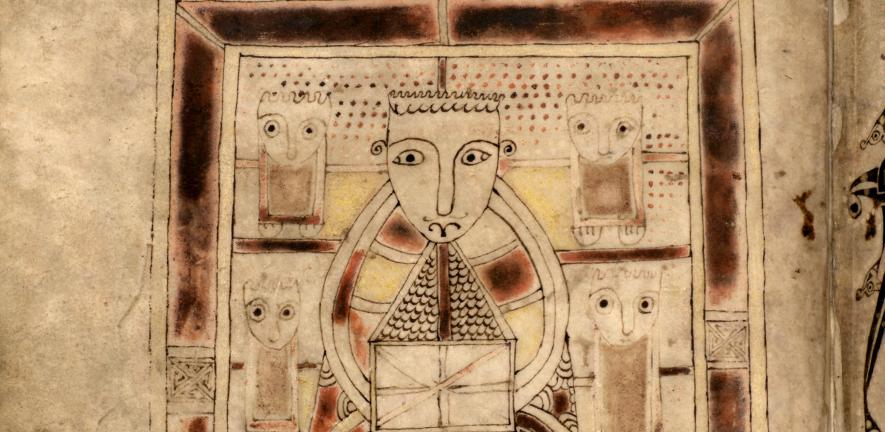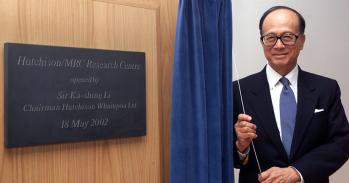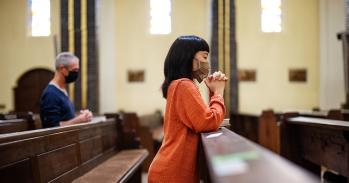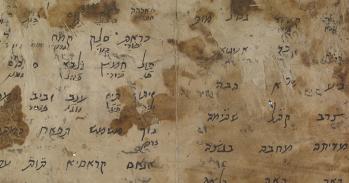
Cambridge University Library is to release digital versions of some of the most significant religious manuscripts in the world - following on from last year’s release of Isaac Newton’s manuscripts and notebooks.
Cambridge University Library is to release digital versions of some of the most significant religious manuscripts in the world - following on from last year’s release of Isaac Newton’s manuscripts and notebooks.
Cambridge University Library preserves works of great importance to faith traditions and communities around the world.
Anne Jarvis
Launched in December last year (2011), the Cambridge Digital Library has already attracted tens of millions of hits on its website. Among the 25,000 new images being made freely available at https://cudl.lib.cam.ac.uk/ are a 2,000-year old copy of The Ten Commandments (the famous Nash Papyrus) and one of the most remarkable ancient copies of the New Testament (Codex Bezae).
While the latest release focuses on faith traditions – including important texts from Judaism, Christianity, Islam, Buddhism, Hinduism and Jainism – many of the manuscripts being made available are also of great political, cultural and historical importance.
One, the tenth-century Book of Deer, is widely believed to be the oldest surviving Scottish manuscript, and it contains the earliest known examples of written Gaelic.
A thirteenth-century Life of Edward the Confessor provides an account of the early English saint and king, produced by a later king for political purposes, and boasts masterpieces of English illumination, including a very graphic portrayal of the Battle of Hastings.
The extensive Cairo Genizah collections, which are being gradually released through the digital library, provide fascinating glimpses into the everyday life of a Jewish community in Egypt over a period of a thousand years. Based at the crossroads of trade and intellectual exchange, the archive of this community represents one of the most important sources for understanding the wider medieval world.
The Library is also beginning to release digital versions of its Islamic and Sanskrit collections, which include both secular and religious texts. The Islamic manuscripts collection includes some of the earliest surviving Qur’ans, while the Library’s Sanskrit manuscripts cover all the major religious traditions of South Asia and include some of the oldest known manuscripts of key religious texts.
A £1.5m lead gift from the Polonsky Foundation in June 2010 made possible the sophisticated technical infrastructure underpinning the digital library. This gift was one of the earliest and largest that the Foundation has given as part of its International Digitisation Project, which aims to make the world's intellectual treasures freely accessible to a global audience. The Polonsky Foundation has also funded the digitisation of much of the content included within this latest release.
Dr Leonard Polonsky said: “I am delighted to see such important materials being made freely available to the world, and I look forward to the many other exciting collections the Library is preparing.”
Dr Polonsky’s landmark benefaction provides a strong basis for attracting further support for this ambitious and important initiative at Cambridge and has already been successful in generating funding for further digitisation.
University Librarian Anne Jarvis said: “Cambridge University Library preserves works of great importance to faith traditions and communities around the world. Because of their age and delicacy these manuscripts are seldom able to be viewed – and when they are displayed, we can only show one or two pages. Now, through the generosity of the Polonsky Foundation, anyone with a connection to the Internet can select a work of interest, turn to any page of the manuscript, and explore it in extraordinary detail.”
Among the religious treasures and collections viewable within the Cambridge Digital Library are:
The Nash Papyrus. Named after the Egyptologist who purchased it at the beginning of the twentieth century, the Nash papyrus is a very fragile second-century BCE manuscript. Before the discovery of the Dead Sea Scrolls, it was by far the oldest manuscript containing text from the Hebrew Bible, and even now it remains among the most ancient.
View at: https://cudl.lib.cam.ac.uk/view/MS-OR-00233/
The Codex Bezae is one of the most important New Testament manuscripts. Containing the Gospels and Acts of the Apostles in Greek and Latin, it is thought to date from the late fourth or early fifth century. Codex Bezae is striking in containing many unique forms of the text, including, a saying attributed to Jesus found in no other sources, a longer ending that was added to Mark’s Gospel and a strikingly different version of Acts. In addition to the high-quality digital facsimile of the Codex, the Cambridge Digital Library includes a new edition of the manuscript with full Greek and Latin transcriptions, including information about its many corrections, prepared by the International Greek New Testament Project (http://www.igntp.org/).
View at https://cudl.lib.cam.ac.uk/view/MS-NN-00002-00041/
The Book of Deer is a tiny pocket gospel book, about 16cm tall and 11cm wide. Usually dated to the first half of the tenth century, the manuscript is of particular importance to Scotland. It is widely regarded as the earliest surviving manuscript produced in Scotland and also contains the earliest examples of written Scots Gaelic, added to the manuscript in the twelfth century at the monastery of Deer in Aberdeenshire.
View at: https://cudl.lib.cam.ac.uk/view/MS-II-00006-00032/
The Life of St Edward the Confessor by Matthew Paris celebrates the life of this important English saint and king. Sponsored by Henry III and possibly owned by Queen Eleanor of Castille, it is a masterpiece of thirteenth-century English illumination and political propaganda.
View at: https://cudl.lib.cam.ac.uk/view/MS-EE-00003-00059/
Several very early fragments of the Qur’an, from the eighth or ninth centuries CE (second or third centuries AH), many written in elaborate script with geometrical ornamentation.
Examples:
https://cudl.lib.cam.ac.uk/view/MS-ADD-01116/
https://cudl.lib.cam.ac.uk/view/MS-ADD-01146/
https://cudl.lib.cam.ac.uk/view/MS-OR-00770/
The Cairo Genizah Collection (selection). The Taylor-Schechter Cairo Genizah Collection is the world’s largest and most important single collection of medieval Jewish manuscripts. Obtained from a synagogue storeroom (genizah) in Egypt in the late 1890s, the collection contains 193,000 manuscript fragments, obtained by a Cambridge professor, covering all aspects of life in the Jewish community at Fustat, near Cairo, over a period of a thousand years. The digital library currently contains several thousand items from the collection. This will expand over the next few years to include the entire collection, along with a further 7,000 fragments from the long hidden Jacques Mosseri Genizah Collection. The digitisation of the Genizah collections has been sponsored by the Jewish Manuscript Preservation Society, the Friedberg Genizah Project, and the Arts and Humanities Research Council (AHRC).
More information and examples at: https://cudl.lib.cam.ac.uk/collections/genizah
Sanskrit Manuscripts (selection). Cambridge’s important collection of Sanskrit manuscripts comprises over 1,600 works written over a thousand year period on different materials, including paper, palm leaf and birch bark. The collection covers many of South Asia’s religious traditions – from the Vedic religion to devotional Hinduism and Tantrism, Theravada to Mahayana and Tantric Buddhism, and Jainism. The digitisation of the Library’s Sanskrit collection is being undertaken as part of an Arts and Humanities Research Council (AHRC)-funded research project to study and catalogue the collection. The digital library currently presents a small initial selection, which will grow significantly in 2013-14.
More information and examples at: https://cudl.lib.cam.ac.uk/collections/sanskrit
This work is licensed under a Creative Commons Licence. If you use this content on your site please link back to this page.





